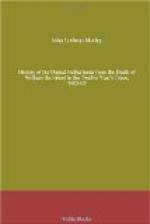The invasion of Ireland under Aquila, so pompously heralded as almost to suggest another grand armada, had sailed in the beginning of the winter, and an army of six thousand men had been landed at Kinsale. Rarely had there been a better opportunity for the Celt to strike for his independence. Shane Mac Neil had an army on foot with which he felt confident of exterminating the Saxon oppressor, even without the assistance of his peninsular allies; while the queen’s army, severely drawn upon as it had been for the exigencies of Vere and the States, might be supposed unable to cope with so formidable a combination. Yet Montjoy made short work of Aquila and Tyrone. The invaders, shut up in their meagre conquest, became the besieged instead of the assailants. Tyrone made a feeble attempt to relieve his Spanish allies, but was soon driven into his swamps, the peasants would not rise; in spite of proclamations and golden mountains of promise, and Aquila was soon glad enough to sign a capitulation by which he saved a portion of his army. He then returned, in transports provided by the English general, a much discomfited man, to Spain instead of converting Ireland into a province of the universal empire. He had not rescued Hibernia, as he stoutly proclaimed at the outset his intention of doing, from the jaws of the evil demon.
The States, not much wiser after the experience of Nieuport, were again desirous that Maurice should march into Flanders, relieve Ostend, and sweep the archduke into the sea. As for Vere, he proposed that a great army of cavalry and infantry should be sent into Ostend, while another force equally powerful should take the field as soon as the season permitted. Where the men were to be levied, and whence the funds for putting such formidable hosts in motion were to be derived, it was not easy to say: “’Tis astonishing,” said Lewis William, “that the evils already suffered cannot open his eyes; but after all, ’tis no marvel. An old and good colonel, as I hold him to be, must go to school before he can become a general, and we must beware of committing any second folly, govern ourselves according to our means and the art of war, and leave the rest to God.”
Prince Maurice, however; yielding as usual to the persuasions or importunities of those less sagacious than himself; and being also much influenced by the advice of the English queen and the French king, after reviewing the most splendid army that even he had ever equipped and set in the field, crossed the Waal at Nymegen, and the Meuse at Mook, and then moving leisurely along Meuse—side by way of Sambeck, Blitterswyck, and Maasyk, came past St. Truyden to the neighbourhood of Thienen, in Brabant. Here he stood, in the heart of the enemy’s country, and within a day’s march of Brussels. The sanguine portion of his countrymen and the more easily alarmed of the enemy already thought it would be an easy military promenade for the stadholder to march through Brabant and Flanders to the coast, defeat the Catholic forces before Ostend, raise the weary siege of that place, dictate peace to the archduke, and return in triumph to the Hague, before the end of the summer.




